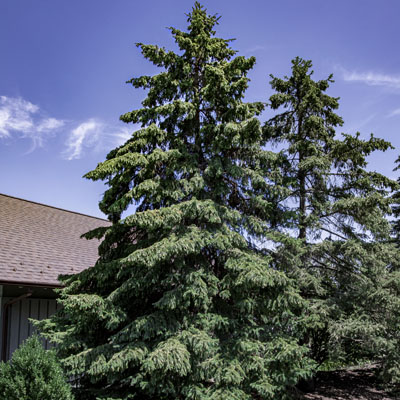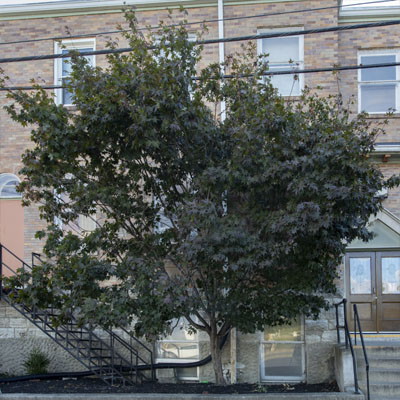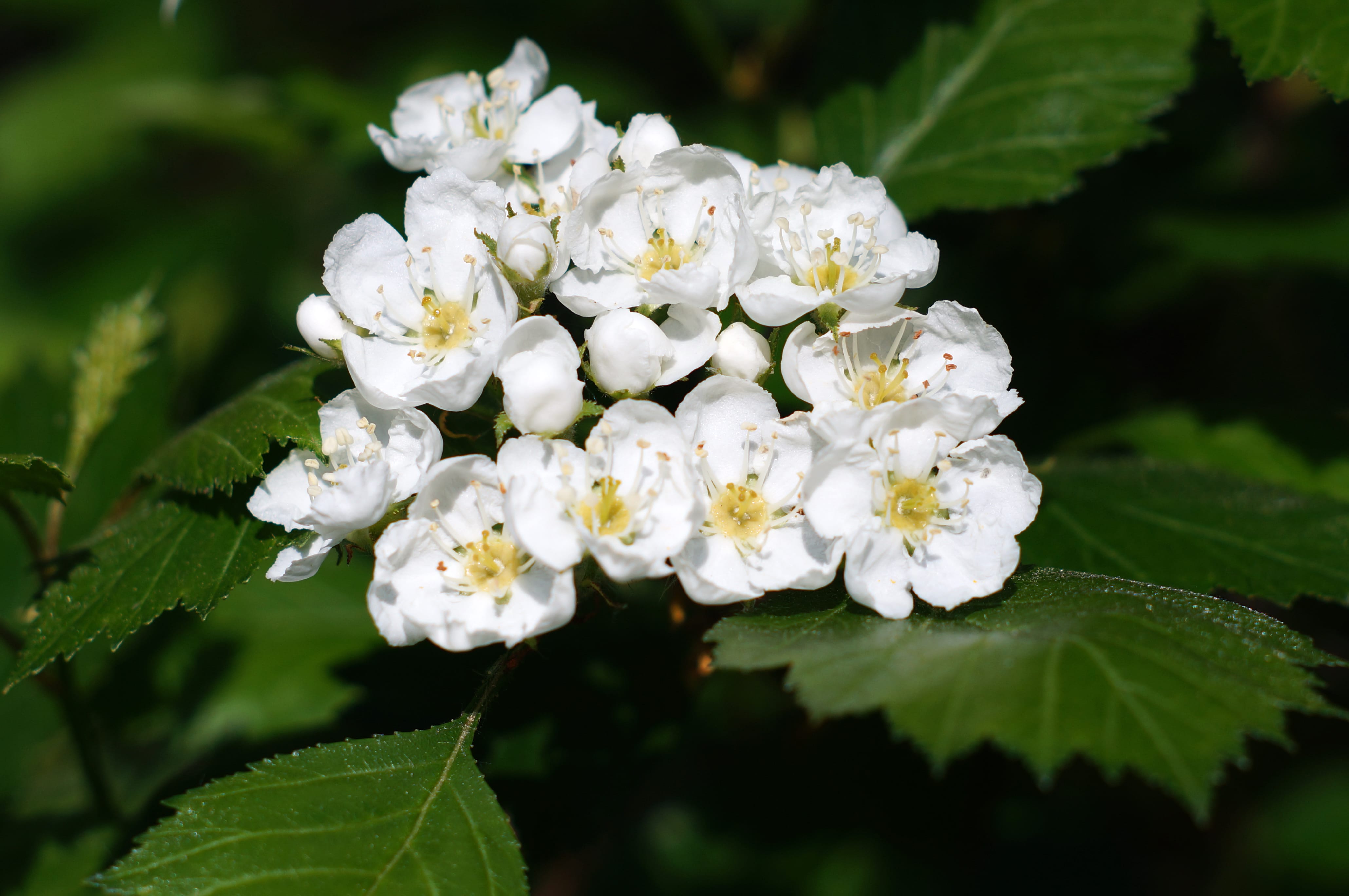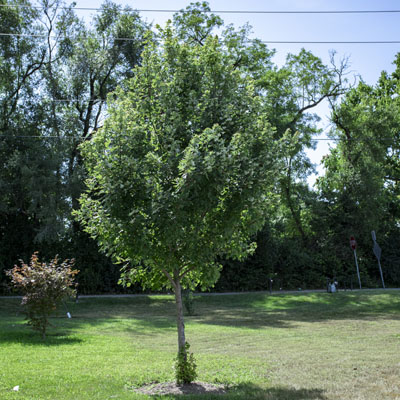Tree Catalog - Best Trees For Dayton, Ohio
Welcome to the Arbor Experts Tree Catalog, where you'll find photos and complete descriptions of the trees we most highly recommend for the Dayton, OH area. All of these trees will do well here and would be a beautiful addition to your yard.
'Crimson Spire' English Oak
Quercus robur x alba 'Crimschmidt'
‘Crimson Spire’ oak is a beautiful hybrid between English oak and White oak, and was selected for its narrow form and showy, reliable red fall color. As its cultivar name suggests, its narrow, upright branching is maintained into maturity. It is tolerant of a wide range of conditions but prefers well-drained soil.
Like its oak parents, ‘Crimson Spire’ has furrowed bark and dark green, lobed leaves, and its acorns are an important winter food source for wildlife. It is native to woodlands, but its tolerance of a range of environmental conditions mean that it is regularly grown in urban settings.
‘Crimson Spire’ grows in USDA Zones 4-7.
Black Hills Spruce
Picea glauca 'Densata'
The state tree of South Dakota, the Black Hills Spruce is a tough tree that is an excellent choice as an accent tree or used as a windbreak. It's a dense, slow-growing tree that reaches 40' tall at maturity with a narrow 15' spread and has fine bluish-green needles. It has no severe pest issues but appreciates moist, well-drained soil and does best when given room to grow with ample air circulation.
Bloodgood Japanese Maple
Acer palmatum 'Bloodgood'
‘Bloodgood’ Japanese maple is an excellent garden or accent tree. Its small size and sweeping branches are beautiful both when covered in leaves and when bare in winter. ‘Bloodgood’ can be grown as a single-trunked standard or a multi-trunk specimen. Multi-trunked trees are valued for their branching patterns and their display of leaves.
‘Bloodgood’ is a good addition to woodland gardens or as an understory shrub or tree.
It is native to Asia, but will grow wherever its cultural requirements are met, including here in the Dayton area. It requires a regular level of moisture and some shade when planted in hot areas, and prefers acidic soil.
‘Bloodgood’ grows in USDA Zones 5-8.
Common Bald Cypress
Taxodium distichum
Though you might think of the bald cypress as a tree that grows in swampy conditions, it does just as well on dry ground here in Ohio. (You might often find them planted around lakes, too).
This type of tree is one of the few deciduous conifers; it loses its needles every fall (hence the name, "bald,") and grows them back every spring. The reddish-brown fall color of the leaves is why we have it listed as one of our best trees for fall color.
Bald cypress can live a very long time (one that was recently discovered is considered to be over 2,000 years old) and grow very large. Ensure that you have enough room for a tree 50 to 80 feet tall and 23 to 30 feet wide (and keep in mind that the roots usually grow out 2-3x further than that!) It likes full or partial sun, slightly acidic and wet soil. The lacy needles will fall off each fall, so don't plant the tree near a driveway unless you want needles all over your car. Overall, it's a great tree that grows well here, is different from your usual conifer, and provides some interest in the fall.
Crusader Cockspur Hawthorn
Crataegus crus-galli 'Cruzam'
‘Cruzam’ (often called 'Crusader') is a thornless variety of cockspur hawthorn that provides multi-season beauty, with white flowers in spring, flaming fall colors, and bright red berries that attract wildlife. A smaller tree, reaching only 25 feet at maturity, 'Crusader' is a good option for urban environments and planting under power lines. It prefers full sun but isn't fussy about soil, watering or heat.
Dr. Merrill Magnolia
Magnolia loebneri 'Merrill'
With its large, fragrant, star-like white flowers in spring and its pointy leaves that turn copper in the fall, 'Dr. Merrill' makes a real statement in the landscape. Growing to 25 feet tall and 30 feet wide, this pyramidal-shaped tree does best in full to partial shade. It does not do well in urban environments (due to pollution), and it prefers well-drained and acidic soil. After planting, it might take a few years for the blooms to appear.
Green Mountain Sugar Maple
Acer saccharum 'Green Mountain'
'Green Mountain' is a sugar maple cultivar that's been grown for almost 60 years and is well-suited to Dayton's climate. It's fast-growing up to 60 feet tall, with a strong, well-branched form and large, dark green leaves that turn a brilliant orange-red in fall. When grown in moist, well-draining soil and part- to full-sun, it's a low-maintenance tree that's resistant to most local tree pests and diseases. Be aware that this is a large tree - it will need enough space to spread out.
Green Vase Zelkova
Zelkova serrata 'Green Vase'
Zelkova serrata is a beautiful deciduous tree that can be planted in parks, used as a shade tree or a street tree, and as a tree for your garden. While its graceful shape and small leaves might suggest delicacy, its hardiness makes it a good choice for parking lots and as a buffer or screening tree.
This tree produces small seeds that do not cause litter problems and, like all zelkovas, has attractive, pointed, elm-like green leaves.
‘Green Vase’ zelkova is noted for its vase shape, fine foliage, and attractive gray bark that flakes and exposes cinnamon-colored inner bark. Because of its resemblance to elm (Ulmus) species and its resistance to Dutch elm disease, it is often used as a substitute for elm trees.
‘Green Vase’ grows in USDA Zones 5-8.
Jane Magnolia
Magnolia x 'Jane'
'Jane' is a small-scale, graceful magnolia that’s ideal for gardens. ‘Jane’ is a magnolia cross that is part of a group of magnolia cultivars developed at the National Arboretum. It’s a late-blooming magnolia, so there is less chance that early blooms will suffer frost damage. When its flowers open, they are large, red-purple with white interiors, and are fragrant.
‘Jane’ can be pruned to form a multi-trunk tree so its branches can best display its large, profuse spring flowers. You can use ‘Jane’ as a specimen or accent tree, or add it to woodland landscapes and mixed borders. Position it so its spring bloom and fall color can be easily viewed.
Because of its naturally shrubby form, ‘Jane’ can be massed to make a loose, informal screen.
Keteleeri Juniper
Juniperus chinensis 'Keteleeri'
A tough evergreen juniper, ‘Keteleeri’ tolerates dry conditions, alkaline soils, full sun, and some pollution and salt. These characteristics make it a good choice for a range of settings, provided that its soil is well-drained. It forms a neat, pyramidal shape reaching 20 feet high and wide, with peeling brown bark, medium-green foliage and large berries that attract birds. 'Keteleeri' has no serious disease or pest problems and is a good choice for privacy screening or as a windbreak.
Princeton American Elm
Ulmus americana 'Princeton'
The Princeton American Elm is more resistant to Dutch Elm Disease than other elm trees (which is why, in 2005, about 90 Princeton elms were planted on Pennsylvania Avenue leading to the White House).
The 'Princeton' cultivar of the American elm grows 50 to 70 feet tall and 30 to 50 feet wide, so be sure it has plenty of room to grow if you plan on planting one. It's extremely fast-growing, and prefers full sun and rich, well-drained soil.
Because it grows so rapidly, proper maintenance pruning is important. It may be susceptible to Japanese beetles, so look for signs of the leaves being eaten.
Redpointe Red Maple
Acer rubrum 'Frank Jr.'
Red maples are prized for their fall color and the Redpointe Red Maple is no exception. This cultivar is also valued for its manageable size, tidy branching pattern, and its narrow, pyramid shape. From its early spring flowers to its autumn leaf show, this tree beautifies your garden all year.
Redpointe grows at a moderate rate to 40’ to 50’ tall with a 25’ to 35’ spread. With this narrower spread, the Redpointe maple fits in small gardens and urban spaces, where its crown of dark green leaves provides shade in summer and its brilliant red fall color makes it a focal point, particularly against a clear blue autumn sky.
Striking bark is another plus: young trees have smooth, light gray bark, while mature trees develop darker, plate-like bark.










